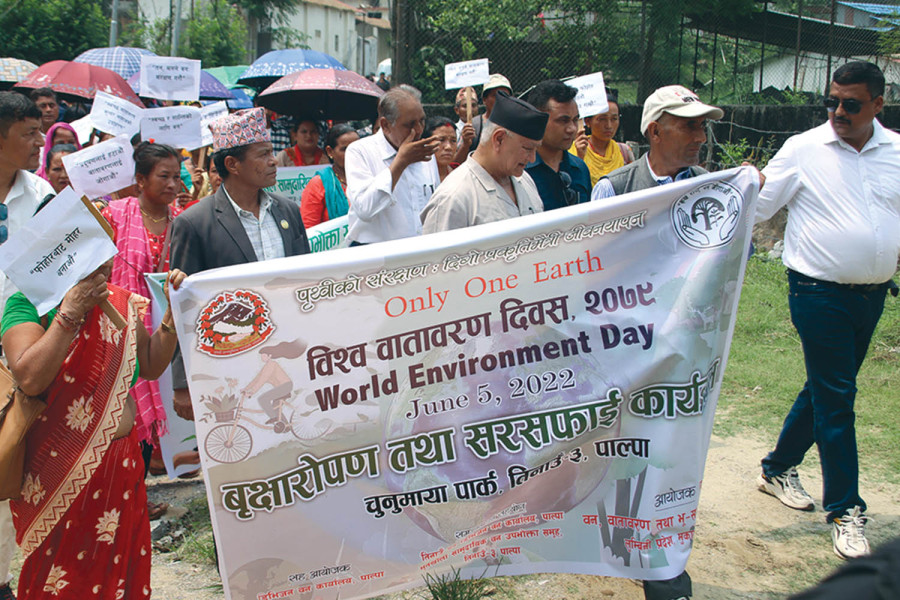Columns
Hazardous flex banners
We should use eco-friendly materials, instead of non-biodegradables, to minimise pollution.
Aditya Acharya
Every year, on June 5, people worldwide celebrate World Environment Day to raise awareness and promote action for protecting and preserving the environment. This year, it was celebrated with the theme "Solutions to Plastic Pollution" under the #BeatPlasticPollution campaign. In Nepal, thousands of national and international non-government organisations, government agencies, community-based organisations and other institutions organised various events such as sanitation programmes, tree plantations, awareness rallies and so on to observe the day.
One common thing in the photos of almost all such programmes, as seen on social media and elsewhere on the internet, was a "flex banner" with messages calling for alternatives to plastic and plastic-based products. Exceptions apart, division and sub-division forest offices under the Ministry of Forests and Environment prepared flex banners to raise awareness about plastic pollution during the celebration of this day.
However, flex banners are made up of the same materials as plastic bags and are non-biodegradable. The most commonly known plastic is Polyethene (PE), whereas the plastic used in flex is usually Polyvinyl Chloride (PVC), the third largest plastic type by volume among 400 million tons of plastic produced worldwide annually and is the most environmentally damaging. PVC, the essential component of the most widely used flex banners we use daily, is known for its durability and resistance to natural decomposition. When burnt, it releases toxic gases that harm the environment and the health of living beings.
After the final photo session of the Environment Day event, the flex banners are useless and are either dumped or released into the environment. Ironically, governmental and non-governmental organisations that advocate protecting the environment print slogans on plastic (flex) and dispose of them after a single use. Flex banners, instead of projectors, are frequently used in conferences and workshops organised in sophisticated hotels. This implies that they do not even know that flex prints are just another type of plastic. Otherwise, why would they print slogans promoting eco-friendly alternatives to plastic on flex banners?
The new normal
Unfortunately, this is not just about Environment Day—these lightweight, durable, weather resistant and low-cost banners are widely used for indoor and outdoor applications such as advertising, exhibitions, trade shows, public information displays, office boards, election campaigns, etc. Moreover, they are seen in all public or in-house events, such as inauguration programmes, birthday celebrations, annual day celebrations, marriage functions, picnics, meetings, workshops, conferences, tree plantation programmes and so on.
Acknowledging the indiscriminate use and environmental harm caused by the PVC flex banners, the Ministry of Environment, Forest and Climate Change of the Government of India has banned such banners used for short-term purposes in government institutions. The state governments of Kerala and Nagaland, among others, have supported the endeavour. It's high time we followed suit instead of importing the same material from India and making using it a habit.
Reduce, reuse, recycle
Research shows that current technologies are not enough to sustainably manage the production and disposal rates of Polyvinyl Chloride (PVC) and that eliminating them is the best waste management option for both environment and human health. Just like plastic bags, flex banners have advantages, but how we use them for a single event—which is not helpful for any other purpose—is bad.
Awareness messages, for example, in the Environment Day celebrations, could be promoted through social media. For events held indoors, projectors can be used to display messages instead of printing a flex banner that will be used only for a few hours. Paper and cardboard can also serve as alternatives to flex banners. But the desire to capture a good-looking photo to post on social media prevents us from using these readily available options. It may be possible to reuse flex banners for making waterproof roof covers, food grain covers, tarps and bags, but the size of such banners designed for a specific purpose will likely defeat the utilitarian purpose. In theory, recycling is possible; however, it is challenging due to the composition of the material, and it is economically not viable.
Considering the challenges involved in waste management and reusing and recycling PVC flex banners, it is important to explore alternative eco-friendly options suggested above to reduce their use. More importantly, the mindset that the success of an event is determined by an appealing photo posted on social media should be changed. Kudos to those walking the talk, but it is crucial for everyone to practice what they preach to others.




 14.72°C Kathmandu
14.72°C Kathmandu















